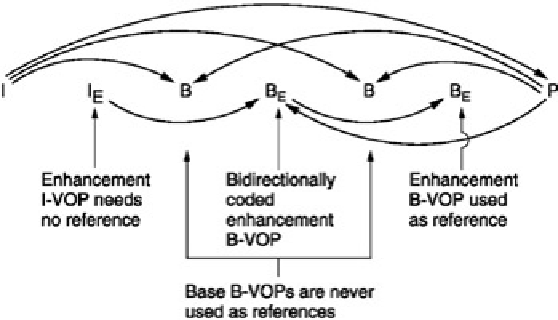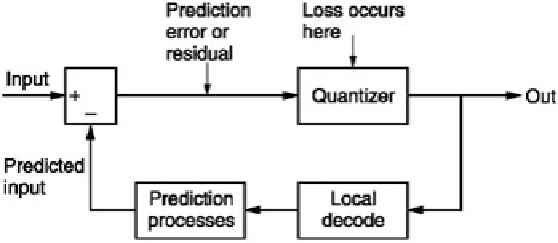Information Technology Reference
In-Depth Information
Figure 5.89:
Temporal scaleability allows new VOPs to be created between base layer VOPs thereby increasing
the picture rate.
Figure 5.90 shows the example of an enhancement B-VOP placed between two VOPs in the base layer.
Enhancement vectors are used to shift base layer pixels to new locations in the enhancement VOP. The
enhancement residual is then added to these predictions to create the output VOP.
Figure 5.90:
This enhancement B-VOP contains vectors to shift base level anchor VOPs. Residuals are then
added to correct the prediction error.
5.31 Coding artifacts
This section describes the visible results of imperfect coding. This may be where the coding algorithm is sub-
optimal, where the coder latency is too short or where the compression factor in use is simply too great for the
material.
Figure 5.91 shows that all MPEG coders can be simplified to the same basic model in which the predictive power of
the decoder is modelled in the encoder. The current picture/object is predicted as well as possible, and the
prediction error or residual is transmitted. As the decoder can make the same prediction, if the residual is correctly
transmitted, the decoded output will be lossless.
Figure 5.91:
All MPEG codecs can be reduced to a lossless prediction process and a lossy coding of the prediction
error or residual.
The MPEG coding family contains a large number of compression tools and many of these are lossless. Lossless
coding tools include the motion compensation, zig-zag scanning and run-length coding of MPEG-1 and MPEG-2
and the context coding and various types of predictive coding used in MPEG-4. It is a simple fact that the more
sophisticated the prediction, the fewer data will be needed to transmit the residual.



